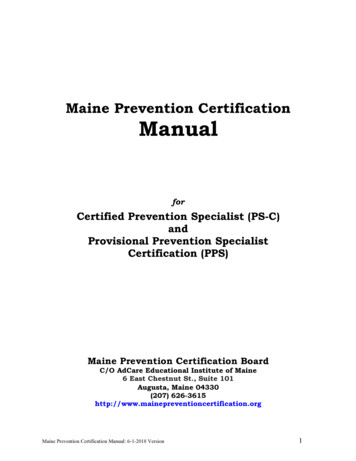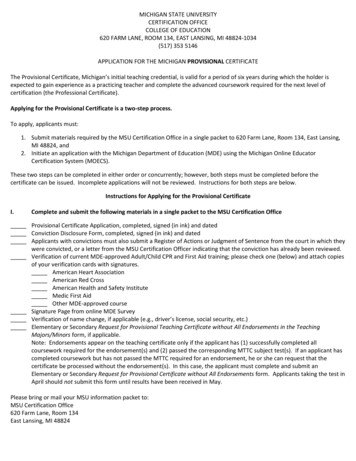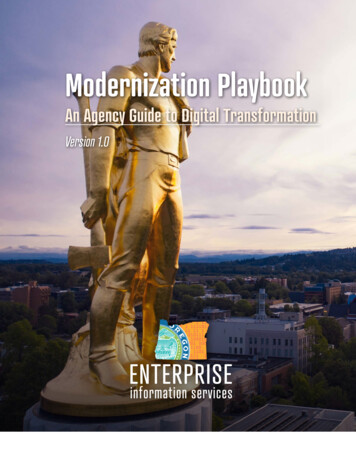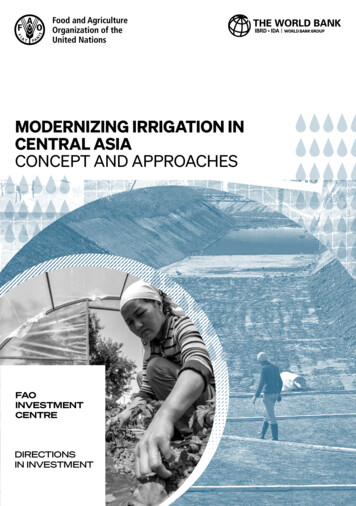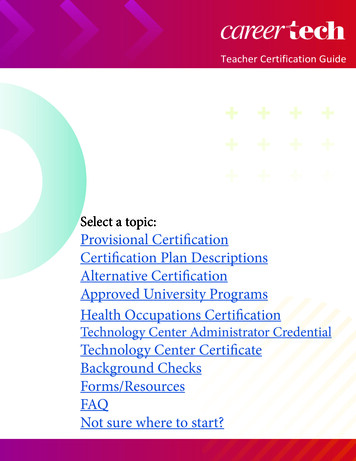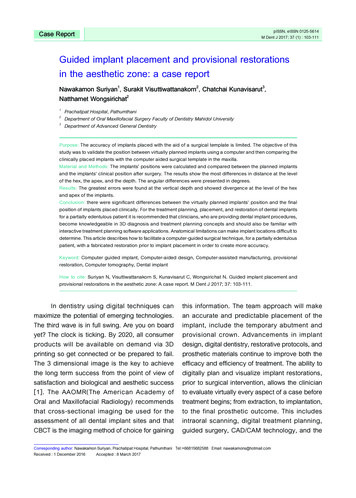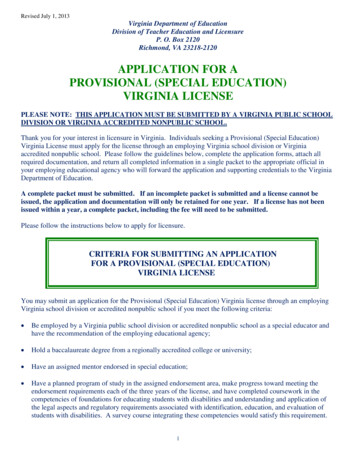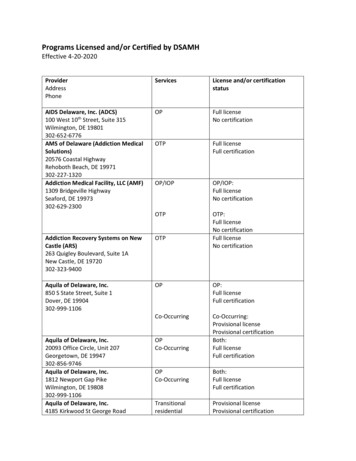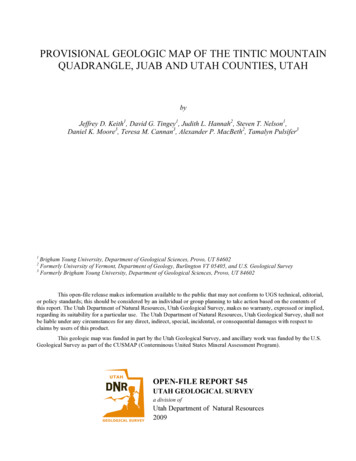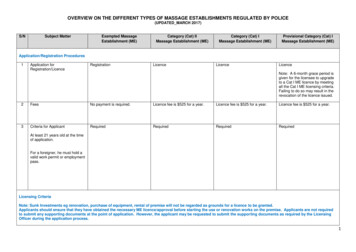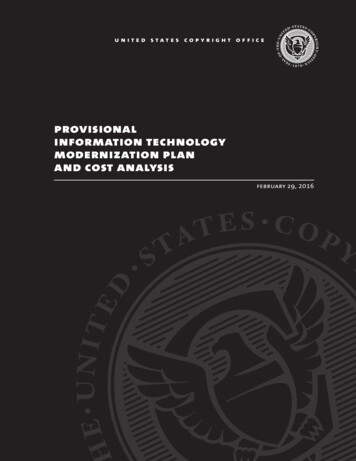
Transcription
united states copyright officeSTRATEGIC PLAN2016-2020provisionalinformation technologymodernization planand cost analysisfebruary 29, 2016
Table of ContentsExecutive Summary . 11.02.03.04.05.06.0Overview and Business Case . 51.1Overview of Future State . 61.2Modernization Roadmap . 91.3Cost Estimate . 91.4Key Considerations and Next Steps . 11Proposed IT Operating Model . 132.1IT Sourcing Model . 132.2Cybersecurity . 17Future Architecture . 203.1Approach . 213.2Overall Architecture . 243.3Mission Services . 243.4Infrastructure Services . 283.5Desktop Services . 293.6IT Service Management (“ITSM”) . 303.7Disaster Recovery (“DR”) . 31Modernization Roadmap . 334.1Timelines for Each Phase . 334.2Analysis of Modernization Roadmap Initiatives . 37Cost Estimate . 425.1Approach . 425.2Assumptions . 435.3Key Findings . 455.4Conclusions . 62Risks and Next Steps . 636.1Identified Risks and Mitigation . 636.2Next Steps . 64Appendices. 65Appendix A – Source Materials . 66Appendix B – Cost Basis of Estimate . 67B.1Introduction . 67B.2Summary & Recommendations . 68B.3Cost Basis of Estimate Report Organization and Contributors . 69B.4Scope and Technical Description . 70
B.5Cost Estimate Results . 71B.6Risks and Issues . 74B.7Ground Rules and Assumptions, Constraints . 75B.8Estimating Methodology . 82Appendix C – USCO Application Scoring Results. 88Appendix D – Supporting Cost Estimate Tables . 91Appendix E – Acronyms . 106Appendix F – Glossary of Terms . 109
Executive SummaryThe United States Copyright Office is pleased to deliver this Provisional Information TechnologyModernization Plan, dated February 29, 2016 (the “IT Plan”) to the House of Representatives, as requiredby the Consolidated Appropriations Act of 2016 (the “Act”). The House Report accompanying the Actrequires the Register of Copyrights to deliver “a detailed plan on necessary IT upgrades, with a costestimate, that are required for a 21st century copyright organization” no later than June 18, 2016, and to1seek public comments regarding a funding strategy and a time frame for completion. As the HouseReport further explains:The Committee fully understands the importance of the Copyright Office as it relates tocreativity and commercial artistic activity not only within the United States but also on aworld-wide basis. In order to serve the copyright owners and the copyright community inthe 21st century, a robust modern information technology (IT) operation will be2necessary.The IT Plan must be read alongside the U.S. Copyright Office Strategic Plan (2016-2020), Positioning theUnited States Copyright Office for the Future, published on December 1, 2015 (the “Strategic Plan”). TheStrategic Plan addresses the national copyright system’s IT, data, and infrastructure needs as they relate3to the Copyright Office’s business, regulatory, and legal responsibilities. As described in the StrategicPlan, modernization of the Copyright Office is a comprehensive undertaking requiring work to proceed onmultiple fronts in tandem, including updates to Office staffing, funding, IT systems, and administrativepractice, as well as potential changes to the copyright laws of the United States. The major regulatorychanges necessary to effectively examine, register, protect, document, and license copyright interestsand information in the digital age cannot be accomplished in the current technology state, however.The IT Plan heeds the Strategic Plan’s call for the Copyright Office of the twenty-first century to be lean,nimble, results-driven, and future-focused, and translates those themes into a comprehensivemodernization plan that can meet the needs of the Office’s customers. For example, the Copyright Officeis currently unable to offer the ability to register works through mobile devices or apps, or to connect viaan API to search public data in real time. Rather, the registration system is tied to a proprietary product, afederally-owned data center, and dated and costly underlying architecture which, even if updated, couldnot permit the kind of flexibility needed for the national copyright system to stay current. The recordationsystem remains paper-based.Meanwhile, the industries at the core of our digital economy—from video game developers to mobiledevice manufacturers, from movie studios to internet streaming companies, from music creators to onlinemusic services—depend upon rapidly changing and innovative technology. The challenge today isensuring that the Copyright Office can meet the future needs of these essential industries. It is clear thatmaking incremental improvements will not be enough. We must shift the approach entirely, and the ITPlan therefore provides a flexible platform that others can build upon for the effortless protection andlicensing of copyrighted works.1H.R. REP. NO. 114-110, at 17 (2015).2Id.3See U.S. COPYRIGHT OFFICE, STRATEGIC PLAN 2016-2020: POSITIONING THE UNITED STATES COPYRIGHT OFFICE FOR THE Future (2015) (“Strategic an/sp2016-2020.html.2016 USCO PROVISIONAL IT PLAN 1
As documented in the following pages, the Copyright Office projects that the modernization effort will costin the range of 165 million over a five-year implementation timeframe. Thereafter, operating costs wouldrequire an increase in the base budget of approximately 25 million. The dollar amount of costs thatwould be funded by fees is unknown at this time. In accordance with the House directive, the Register is4seeking public comments as to both the funding strategy and implementation timeline. The Office haspublished a Notice of Inquiry on these matters, timed with the release of the IT Plan, and will report backto Congress with a summary and recommendations as soon as possible.Among other main points, the IT Plan reduces costly infrastructure by embracing well-establishedalternatives. For example, it does not require investment in a sizeable physical plant or data center.Rather, it embraces well-established alternatives, including cloud services and mobile technologies thatare prevalent in the consumer and business markets. It prioritizes data integrity and security controls, anddecreases risk by spreading operations among multiple partners or vendors. The Copyright Office wouldbe responsible for phasing out legacy systems, and would assume a clean-slate, mission-critical strategyfor moving forward. To this end, the IT Plan makes several key assumptions, including: (1) modernizationmust be managed from within the Copyright Office, utilizing individuals who work alongside of, and arefully accountable to, the Office’s legal and business experts; and (2) modernization requires, and willreceive, singular attention and around-the-clock dedication.With respect to the Strategic Plan, the IT Plan ties most directly to Goal 5, which states that a robust,responsive, and highly secure enterprise architecture will form the backbone of a modern CopyrightOffice. These government systems should inspire confidence and encourage participation in day-to-dayservices and transactions. Custom search tools should yield quick, authoritative results. In short, moderntechnology should support all aspects of the Copyright Office’s mission and adapt to evolving needs. TheIT Plan incorporates the underlying themes of the Strategic Plan, namely, that the twenty-first century5Copyright Office must be lean, nimble, results-driven, and future-focused.Both the Strategic Plan and the IT Plan draw on four years of Copyright Office deliberations regardingcurrent and future services. This groundwork was carried out by staff at all levels, and involved a numberof internal committees, public meetings and public reports. These significant efforts include a completely6revised Compendium of Copyright Office practices, published on December 22, 2014, a major report thatinforms the legal parameters of transforming and automating the copyright recordation system, published7on January 7, 2015, and a report recommending technological upgrades to the registration and8recordation functions, published on February 18, 2015. The Strategic Plan not only sets a path forcopyright administration in the twenty-first century, but also provides a flexible basis for supporting suchfurther statutory duties, databases, and regulatory programs that Congress may choose to assign to theOffice going forward.In the last few years, the Copyright Office also has worked with Congress to address gaps in thecopyright law and to advise on changes that may be necessary to ensure a balanced and effectivecopyright regime in the modern age. The House Judiciary Committee, in particular, has conducted more4H.R. REP. NO. 114-110, at 17 (2015).5See Strategic Plan at 7.6See U.S. COPYRIGHT OFFICE, COMPENDIUM OF U.S. COPYRIGHT OFFICE PRACTICES (3d ed. 2014).7See U.S. COPYRIGHT OFFICE, TRANSFORMING DOCUMENT RECORDATION AT THE UNITED STATES COPYRIGHT OFFICE (Jan. 2015).8See U.S. COPYRIGHT OFFICE, REPORT AND RECOMMENDATIONS OF THE TECHNICAL UPGRADES SPECIAL PROJECT TEAM (Feb. 2015).2016 USCO PROVISIONAL IT PLAN 2
than twenty hearings on the state of copyright law since 2013, including a hearing devoted to the current9and future functions and resources of the U.S. Copyright Office. In support of this work, the Office hasundertaken sixteen policy and technical studies for the benefit of House of Representatives and theSenate, delivering ten completed policy and technical reports, which have built on the significant policy10work of previous Registers over the past few decades. Every study undertaken by the Office hasincorporated opportunities for public notice and comment.The Register’s Office also has prioritized the organizational structure of the Copyright Office during thelast few years to ensure that the Office’s current statutory responsibilities and related operations aresupervised by sufficiently qualified experts. For example, the Office now has senior leaders overseeingtechnology planning, copyright recordation, and public information, and has deputies assisting with the11significant supervisory workload in the Office’s registration, legal, and policy offices. These seniorleaders will be working with their respective staffs in the years ahead to further build, reorganize, or refine12their respective departments and to align activities to modernization objectives.As requested by the House of Representatives, the IT Plan is comprehensive and exhaustive. It presentsa fully-mapped out future-state IT enterprise and a detailed cost analysis for a modern IT environment forthe national copyright system. In preparing it, the Copyright Office employed and incorporated federalgovernment best practices, as identified by OMB, GAO, and other authorities. For example, the IT Planintegrates IT security into enterprise architecture processes, presents five-year lifecycle costs ofimplementation, and provides a cost basis of estimate report to provide for proper documentation of the13cost estimate.Together, the Strategic Plan and the IT Plan provide a modernization approach that integrates enterprisearchitectures, cloud services, security controls, staffing requirements, and other operational authoritiesthat will transform copyright administration in the United States. As explained further in the overview,customers will be able to transact with the Copyright Office easily, quickly, and from anywhere at anytime, using any number of consumer platforms to secure copyrights and access data, including licensingor public domain information. Systems will yield quick, authoritative results, encouraging participation,partnerships, and commerce. As copyright law and copyright businesses evolve, so too will copyrightadministration.Finally, in presenting the Strategic Plan and the IT Plan, the Copyright Office is mindful that Congresscontinues to deliberate on a number of legal and policy matters relating to copyright administration andthe copyright law. As such, the business and IT improvements anticipated in the Strategic Plan and ITPlan are not the entirety of modernization discussions. As noted in the Senate Appropriation Committee’s2016 Report:9See U.S. Copyright Office: Its Functions and Resources: Hearing Before the H. Comm. on the Judiciary, 114th Cong. (2015); Strategic Plan at 53–54;Congressional Hearings on the Review of the Copyright Law, U.S. COPYRIGHT OFFICE, http://copyright.gov/laws/hearings; see also Improving CustomerService for the Copyright Community: Ensuring the Copyright Office and the Library of Congress Are Able to Meet the Demands of the Digital Age:Hearing Before the H. Comm. on Administration, 114th Cong. (2015).10See Policy Reports, U.S. COPYRIGHT OFFICE, http://copyright.gov/policy/policy-reports.html; Active Policy Studies, COPYRIGHT.GOVhttp://copyright.gov/policy/.11See Strategic Plan at 47.12See USCO Leadership, U.S. COPYRIGHT OFFICE, http://copyright.gov/about/leadership/; Organization of the U.S. Copyright Office, U.S. COPYRIGHTOFFICE (2015), http://copyright.gov/docs/c-711.pdf.13See e.g., Best Practices and Leading Practices in Information Technology Management, U.S. GOV’T ACCOUNTABILITY OFFICE,http://www.gao.gov/key issues/leading practices information technology management/issue summary; Computer Security Resource Center,Federal Information Security management Act (FISMA) Implementation Project, NAT’L INST. OF STANDARDS AND html; OFFICE OF MGMT & BUDGET, GUIDANCE ON EXHIBITS 53 AND 300 – INFORMATION TECHNOLOGY AND EGOVERNMENT (2012), /assets/egov docs/fy14 guidance on exhibits 53 and 300.pdf.2016 USCO PROVISIONAL IT PLAN 3
The Committee finds that it is necessary to ensure that effective, efficient, and secure systems are inplace at the Copyright Office to support the needs of all copyright-related industries. The Committeenotes that, in addition to ongoing technological and process improvements, modernization of theCopyright Office could include proposed alternatives to its current structure and location within theLibrary of Congress. The Committee encourages an open dialogue to consider all options that allow14for a thriving and efficient Copyright Office in the modern economy.The Copyright Office appreciates the complexity of these Congressional discussions and is pleased toprovide this provisional IT Plan as requested and ahead of schedule. The IT Plan is flexible in that it maybe implemented according to a variety of governance protocols, approvals and controls between theCopyright Office and larger Library of Congress. In envisioning a robust modern IT operation needed for a15twenty-first copyright organization, it does, however, necessarily depart from the status quo in which theCopyright Office manages software applications and the Library of Congress manages underlying ITsystems. Rather, the Copyright Office would have maximum responsibility for operations relating to thenational copyright system and the services that the Office provides.In providing this IT Plan, the Copyright Office appreciates the support of Deloitte Consulting, LLP, whichprovided expert consulting services on the modernization plan and associated costs, and Gartner, Inc.,which provided independent review and validation of the cost analysis and methodology. In the monthsahead, the Copyright Office looks forward to refining these goals with Congress, the Library, the GAO,and the public.All Copyright Office reports, testimony, rulemakings and public inquiries related to information technologyor modernization are available at www.copyright.gov. Information about appropriations, IT spending, and16budget justifications can be found online.Maria A. PallanteUnited States Register of Copyrights14S. REP. NO. 114-64, at 40 (2015).15H.R. REP. NO. 114-110, at 17 (2015).16See Budgets, LIB. OF CONGRESS, ressional-budget-justifications/.2016 USCO PROVISIONAL IT PLAN 4
1.0 Overview and Business CaseThis IT Plan, when implemented, would change a number of existing paradigms. Copyright Registrationwould move away from a large proprietary software product managed by the Copyright Office to a modelthat enables third parties to build a variety of products on an open source technology platform that canseamlessly interoperate with Copyright Office systems. The IT Plan would markedly minimize data centerand other infrastructure needs and, instead, utilize a variety of cloud strategies. These cloud strategieswould permit the USCO to implement examination and documentation practices that are tailored to thevariety and complexity of copyrighted works in the digital age. Copyright owners will have an array ofregistration options to choose from, and be able to employ them from mobile devices as well as businessto-business interfaces. For example, a musician recording a song on a smartphone will be able toseamlessly send her song and the associated data to the Copyright Office for examination andregistration. On the back end, users of copyright data, including licensing or public domain information,will have simple access to timely and authoritative data that can be used to build new businesses oranalyze global trends.The Copyright Recordation system would move from a paper-based intake system to an automatedsystem where recording parties may enter their own information, using metadata standards established oradopted by the USCO. For example, a party could record a change in copyright ownership immediately atthe time of contracting. As appropriate or required, the USCO would exercise quality review consistentwith the requirements of the Copyright Act, i.e., to ensure priority filing and authoritativeinformation. Digital search capabilities will provide users with dynamic access to the Office’s recordationdata. Moreover, the USCO will integrate Registration and Recordation data and databases that arecurrently siloed into a comprehensive System of Records, to provide a more seamless chain of title fromregistration to licenses to transfers and the public domain. Meanwhile, the IT Plan prioritizes strong ITsecurity standards, and will protect the integrity of and access to nonpublic data and materials.Collectively, these changes will engender more participation in national copyright administration. Theplanned comprehensive IT modernization will benefit all USCO systems, including the administration ofstatutory licenses, public information services, expert impartial assistance to Congress, the courts, andexecutive branch agencies on questions of copyright law and policy, and its back-office operations. Byaddressing the services and needs of the national copyright system in an integrated fashion, the USCOwill efficiently prioritize its work and leverage synergies across various divisions and statutory duties.In developing the Provisional Information Technology Modernization Plan (“IT Plan”), the United StatesCopyright Office (“USCO”) undertook a holistic review, including a comparison of the USCO’s objectivesfor a vision of the future state to a defensible cost estimate. All of these considerations themselves have anumber of variables. The overall issues that frame this modernization plan are shown below in Figure 1.0.2016 USCO PROVISIONAL IT PLAN 5
Figure 1.0: USCO IT Plan Overview1.1 Overview of Future StateThe USCO’s current information technology (“IT”) operating model is essentially a shared servicesarrangement whereby the Copyright Technology Office manages USCO systems at the applicationlayer (for example, the online copyright registration system) and the Library of Congress (“LoC”)provides IT infrastructure and network support (for example, servers, storage, and databaseadministration). The USCO applications are hosted at the LoC’s Madison Building Data Center,which is controlled and managed by LoC staff. This structure places the USCO in a unique positionto take advantage of “As a Service” IT technologies, such as cloud service delivery models, and theproposed architecture incorporates these technologies where reasonable. Core drivers enabling theUSCO to consider cloud delivery models are shown below in Figure 1.1-1.2016 USCO PROVISIONAL IT PLAN 6
Figure 1.1-1: Drivers Enabling USCO to Consider Cloud Delivery ModelsCombined, these drivers position the USCO to take advantage of technologies that enable ITdelivery of capabilities and services in a timely, scalable, and iterative manner, supporting theUSCO’s vision of becoming a twenty-first century model for government.The USCO administers several mission-critical services, including the national copyright registrationand recordation systems, an online database of records of copyright ownership, and copyright.gov.Within the USCO, staff use a variety of systems to accomplish their work. Under this IT Plan, allmission-critical services and systems will be re-platformed and designed to achieve user-centriccomputing for both external and internal users.The proposed architecture makes use of cloud-enabled and cloud-provided services that give theUSCO scalability, flexibility, and Operational Expense (“OPEX”)-focused spending. Hosting keymission systems and services outside of the Madison Data Center will require tighter governanceand Service Level Agreements (“SLAs”) with vendors to ensure adequate service delivery andsecurity.Key characteristics of this architecture include: Platform as a Service (“PaaS”)- Based Mission Services – The USCO will develop, operate,and maintain multiple mission-critical services with a limited transition period. Using a PaaSsolution to build mission-critical applications will enable the USCO to meet the followingobjectives: Prioritize limited resources on highest value-add activities Adapt to changing needs using platform-enabled scaling Reduce application management and operation complexity through standardization Secure IT environment (via a Federal Risk and Authorization Management Program17(“FedRAMP”)-compliant cloud provider ) Lower upfront costs and expected Capital Expenses (“CAPEX”) Minimal Infrastructure Owned and Operated by the USCO – The USCO will own and host asmall, core subset of infrastructure to enable future state operations, including: User authentication and directory services capabilities Back-office infrastructure such as printers and voice hardware17Applications from FedRAMP-compliant providers will still need to receive a valid Authorization to Operate (ATO) that specifically authorizes the useof the application for the USCO.2016 USCO PROVISIONAL IT PLAN 7
Core networking equipment (with built-in redundancy) Remote user access points Infrastructure needed to enable off-line, off-site backups of critical enterprise data Power backupUSCO IT Focused on High Value-Add Activities – The USCO IT will focus on high value-addactivities like management, strategy, architecture, and engineering. This provides flexibility toprocure support from service providers. The USCO IT will maintain responsibility for thefollowing: Cybersecurity (including operating model and standards/requirements) Disaster Recovery (“DR”) including data integrity, Recovery Time Objectives (“RTOs”),Recovery Point Objectives (“RPOs”) Enterprise data (including data model and data governance) Strategy, enterprise architecture, solution engineering, and project delivery Mission-critical application development supportNon-Core Mission Services Sourced Rather than Built – The USCO will need to transition itsIT operating model to be focused on governance, architecture, solution engineering, and vendormanagement. The USCO will source IT and non-IT shared services, such as: IT Service Management (“ITSM”) support (e.g., service desks) IT operations support (e.g., server patching, archive storage environment maintenance)Finally, given the importance of security to USCO operations, the future state will adopt FedRAMP’sstandardized approach to security assessment, authorization, and continuous monitoring for cloudproducts and services. The security provided by FedRAMP compliant solutions will serve as abaseline that can be augmented as needed.Figure 1.1-2: FedRAMP Summary2016 USCO PROVISIONAL IT PLAN 8
1.2 Modernization RoadmapThe IT Plan is designed to be phased in sequentially. To enable delivery of the right capabilities atthe right time, the IT Plan logically phases and prioritizes thirty-four proposed initiatives based oncriticality, complexity, and cost. This results in the phases shown in Figure 1.2-1:Figure 1.2-1: Overview of the Modernization RoadmapThese phases delineate how the USCO can achieve its goal of a modern IT system, and includegeneral timeframes.1.3 Cost EstimateAs a companion to the IT Plan, the USCO has developed a high-level notional cost model. The costmodel provides a high-level understanding of the budget required to transition to the desired futurestate and also to sustain the ongoing IT costs over a five-year period.To provide a holistic perspective, the cost model includes the following key cost elements: Budget required to fully design, develop, and deploy the proposed future state architecture Budget required to continue to support the on-going operations of the future state architecture fora five-year period Budget required to support technology refresh of IT hardware (e.g., three years for laptops, fouryears for core infrastructure hardware) Budget required to operate a fully-modernized IT organiz
time, using any number of consumer platforms to secure copyrights and access data, including licensing or public domain information. Systems will yield quick, authoritative results, encouraging participation, partnerships, and commerce. As copyright law and copyright businesses evolve, so too will copyright administration.
